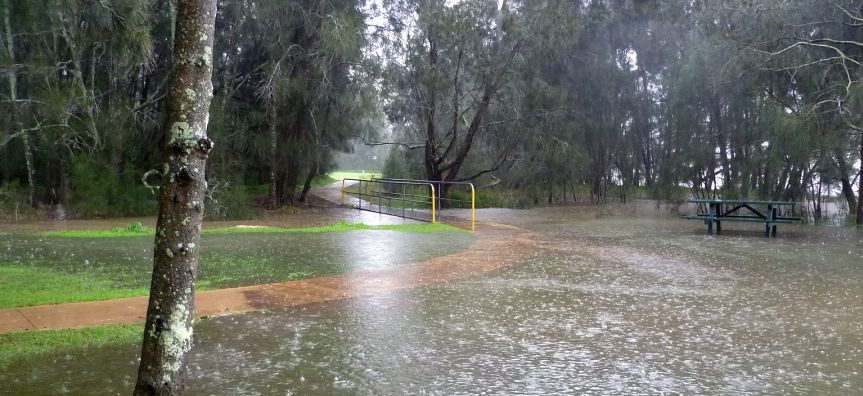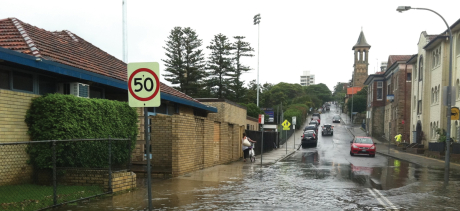
Living in a beautiful coastal area traversed by creeks and dotted with coastal lagoons comes with the risk of flooding. Northern Beaches Council continues to undertake a program of studies and investigations to identify the areas at risk of flooding and how this can be managed.
Flood Hazard Map
Council's Flood Hazard Map shows the extent of land identified as flood prone throughout the Northern Beaches. You can enter your property's address to zoom in to that address.
Flood affected areas are divided into three precincts:
- The Medium Flood Risk Precinct is equivalent to the Flood Planning Area, and covers all flood prone land which is affected by the 1% Annual Exceedance Probability (AEP) flood (equivalent to the 1 in 100 year flood) with a freeboard added.
- The High Flood Risk Precinct lies within the Medium Flood Risk Precinct, and covers flood prone land which is subject to a high hydraulic hazard.
- The Low Flood Risk Precinct covers flood prone land affected by the Probable Maximum Flood (PMF) but which is outside the Medium Flood Risk Precinct. The PMF is equivalent to the largest ever conceivable flood.
Types of flooding
Floods can be dangerous. You should never enter flood waters. There are two kinds of floods that occur naturally on the Northern Beaches: flash flooding and lagoon flooding.
1. Flash flooding
Flash flooding occurs when heavy rainfall causes creeks to break their banks, or the stormwater network to exceed its capacity and overflow. Flash floods happen suddenly with little or no warning and recede relatively quickly.
2. Lagoon flooding
Lagoon flooding occurs due to runoff after heavy rainfall and/or ocean storm surge. The water level in the lagoon rises and spills on to the surrounding low-lying floodplain. Water levels drop when flood waters can escape through the lagoon entrance.
The four lagoons in the Northern Beaches (Narrabeen, Dee Why, Curl Curl and Manly) are known as ICOLLs (Intermittently Closed and Open Lakes and Lagoons). There are about 70 ICOLLs on the NSW coastline. In a natural system, the lagoon entrance remains closed until rainfall in the catchment fills the lagoon, raising water levels enough to overtop the sand barrier and scour a new channel to the ocean. Due to the irregularity of rainfall and the volume of sand that can accumulate at the lagoon entrance, this natural opening can occur infrequently. For example, Narrabeen Lagoon remained closed for four years during the 1924-1928 drought.
Further information on the opening and closure of coastal lakes and lagoons can be found at Department of Primary Industries.
Information on how Council manages the entrances of the lagoons to reduce the risk of flooding to surrounding properties can be found on the Lagoons page.
Floodplain Risk Management Process
Council follows the NSW Government’s floodplain risk management process to identify and manage flood risk. This is a four stage process resulting in an adopted plan for managing flood prone land:
- Flood Study – identification of flood risk
- Floodplain Risk Management Study – identification and assessment of a range of floodplain management options to reduce flood risk
- Floodplain Risk Management Plan – a comprehensive plan setting the strategic direction for the management of flood prone land through the implementation of a range of options
- Implementation of Floodplain Risk Management Plan – implementation of floodplain management options in accordance with priority and financial constraints.
The flood study reports produced as part of this process are available online.
Planning controls for flood prone areas
One of the principal recommendations for managing flood risk is the adoption of planning controls for flood prone areas. Planning controls, sometimes known as flood related development controls, include the setting of floor levels above known flood levels. These ensure the end use of a development is compatible with the known flood hazard.
Planning controls can be found in the Development Control Plan (DCP) and Local Environment Plan (LEP) on the Planning Controls page.
Guidelines for Development on Flood Prone Land are available online to provide advice to applicants on how to obtain flood information from Council, how to determine what rules apply on flood prone land, and how to prepare a Flood Management Report. Reference to flood risk management can also be found in the Water Management for Development Policy.
Northern Beaches Flood Information Network
Northern Beaches Council in conjunction with the State Emergency Service and Manly Hydraulics Laboratory have established an innovative online flood warning system for the region.
The system involves the installation of a number of rainfall and water level gauges that provide live data on where and when flooding may occur, lagoon levels, weather warnings and any recent or forecast rainfalls.
What you can do to protect your home and family
If your property’s on flood prone land be prepared and vigilant. Use the online flood warning system for up-to-the-minute news on current rainfall, flood warnings and safety advice.
Also, the SES FloodSafe website can alert you on flooding in your area. Call for emergency help in floods, storms and tsunamis on 132 500.
Documents
Useful links
- Flood Hazard Map
- NSW State Emergency Service
- Northern Beaches Flood and Information Network
- Bureau of Meteorology
- Floodplain Management Australia
- Flood Risk Management Manual (June 2023)
- Development on flood prone land
- Property Search
- Flood Information Report Application
- Water Management for Development Policy

